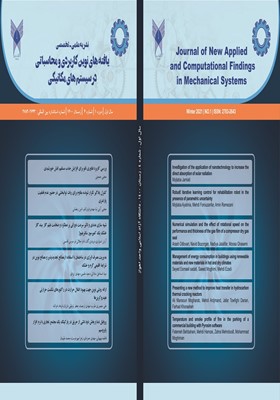بررسی کاربرد فناوری نانو برای افزایش جذب مستقیم تابش خورشیدی
محورهای موضوعی : یافته های نوین کاربردی و محاسباتی در سیستم های مکانیکی
1 - گروه فیزیک، واحد نراق، دانشگاه آزاد اسلامی، نراق، ایران،
کلید واژه: کلکتور خورشیدی, نانوسیال, فناوری نانو, بهینهسازی انرژی, تابش خورشیدی,
چکیده مقاله :
هدف این تحقیق ارزیابی پتانسیل نانوسیال های خورشیدی (مایع با نانوذرات پراکنده) برای جذب مستقیم تابش خورشید و تولید بخار است. در حال حاضر، سیستمهای انرژی حرارتی خورشیدی متحمل تلفات زیادی به دلیل فرآیندهای انتقال حرارت میشوند، بنابراین، توسعة فناوری نانو و دستاوردهای آن مانند نانو ذرات مختلف، امیدهای زیادی را در جهت افزایش کارایی کلکتورهای خورشیدی از طریق جذب مستقیم نور خورشید ایجاد نموده است. به منظور استفاده بهینه از سیستمهای نانوسیال خورشیدی، نیاز به شناسایی و مطالعه آنها میباشد. در این تحقیق چهار نانوسیال مختلف سنتز، مشخص و ارزیابی شده است. دو مورد از آنها نانوسیال مبتنی بر آب و دو مورد دیگر نانوسیال مبتنی بر روغن حرارتی بودند. همچنین خواص نوری نانوسیالها در دمای اتاق با یک اسپکتروفتومتر اندازهگیری شده و با سیال پایه مقایسه گردیده است. خواص نوری، به غیر از اندازهگیری در دمای اتاق، پس از عملیات حرارتی انجام شده بر روی نانوسیالها در دمای بالا نیز ارزیابی شده است. این افزایش دما با هدف بازآفرینی شرایط عملیاتی برای کسانی که به کاربردهای واقعی نزدیک تر هستند، می باشد. اندازهگیریهای DLS یک اندازه متوسط هیدرودینامیکی مشابه 138 نانومتر برای نمونه حاوی SDS و 135 نانومتر برای نمونه حاوی SDS و PVP را نشان میدهند.
The purpose of this study is to evaluate the potential of solar nanofluids (liquid with dispersed nanoparticles) for direct absorption of solar radiation and steam production. At present, solar thermal energy systems suffer great losses due to heat transfer processes, therefore, the development of nanotechnology and its achievements such as various nanoparticles, has created high hopes to increase the efficiency of solar collectors through direct absorption of sunlight. In order to make optimal use of solar nanofluid systems, it is necessary to identify and study them. In this research, four different nanofluids have been synthesized, identified and evaluated. Two of them were water-based nanofluids and the other two were thermal oil-based nanofluids. Also, the optical properties of nanofluids were measured at room temperature with a spectrophotometer and compared with the base fluid. The optical properties, in addition to being measured at room temperature, have also been evaluated after heat treatment on nanofluids at high temperatures. This temperature increase is intended to recreate operating conditions for those closer to the actual applications. DLS measurements show a similar hydrodynamic average of 138 nm for the sample containing SDS and 135 nm for the sample containing SDS and PVP.
[1] Jamiati, M. (2020). Fabrication of solar cells based on CZTSSe films with optimized chemical composition. Journal of Quantum Chemistry and Spectroscopy, 11(35), pp 23-30.
[2] Sun, W., Huang, R., Ling, Z., Fang, X., Zhang, Z. (2020). . Numerical simulation on the thermal performance of a PCM-containing ventilation system with a continuous change in inlet air temperature. Renewable Energ, 145, pp 1608-1619.
[3] Jidhesh, P., Arjunan, T. V., Gunasekar, N. (2021). Thermal modeling and experimental validation of semitransparent photovoltaic- thermal hybrid collector using CuO nanofluid. J. Clean. Prod., 316, pp 128360.
[4] Jamiati, M., Khoshnevisan, B., Mohammadi, M. (2018). Second- and third-order elastic constants of kesterite CZTS and its electronic and optical properties under various strain rates. Energy Sources, Part A: Recovery, Utilization, and Environmental Effects, 40(8), pp 977–986.
[5] Otanicar, T. P., Phelan, P. E., Golden, J. S. (2009). Optical properties of liquids for direct absorption solar thermal energy systems. Solar Energy, 83, pp 969–977.
[6] Jamiati, M. (2021). Modeling of Maximum Solar Power Tracking by Genetic Algorithm Method. Iranian Journal of Energy and Environment (IJEE), 12 (2), pp 118-124.
[7] Xie, H., Wang, J., Xi, T., Liu, Y., Ai, F., Wu, Q. (2002). Thermal conductivity enhancement of suspensions containing nanosized alumina particles. Journal of applied physics, 91, pp 4568–4572.
[8] Faridi Khouzestani,R,Ghafouri,A,(2020) , Numerical study on heat transfer and nanofluid flow in pipes fitted with different dimpled spiral center plate, Journal SN Applied Sciences.2(2), pp 1-19.
[9] Furio, A., G. (2019), On the use of nanofluids to enhance the direct absorption of solar radiation, A dissertation presented by Alexandra Gimeno Furio for the Degree of Doctor from the Universitat Jaume, Castell ́on de la Plana.
[10] Fernandez-Garcıa, A., Zarza, E., Valenzuela, L., Perez, P. (2010). Parabolic-trough solar collectors and their applications. Renewable and Sustainable Energy R eviews, 14, pp 1695–1721.
[11] Mercatelli, L., Sani, E., Fontani, D., Zaccanti, G., Martelli, f., Ninni, P. D. (2011). Scattering and absorption properties of carbon nanohorn-based nanofluids for solar energy applications. Journal of the European Optical Society-Rapid Publications, 6, 11025.
[12] Assael, M. J., Chen, C. F., Metaxa, I., Wakeham, W. A. (2004). Thermal conductivity of suspensions of carbon nanotubes in water. International Journal of Thermophysics, 25 (4), pp 971-985.

